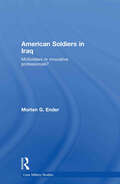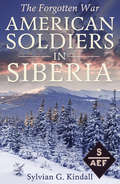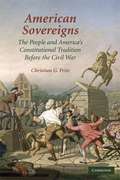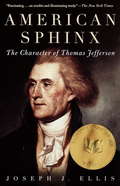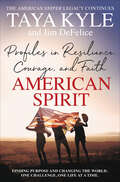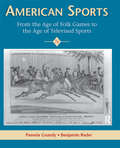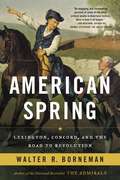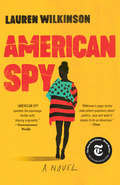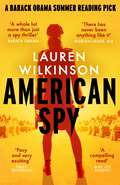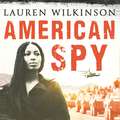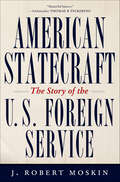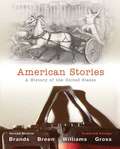- Table View
- List View
American Soldier of WWII: D-Day, A Visual Reference
by Denis HambuckenOn June 6, 1944, 75,000 American men landed on the beaches of Normandy. The opening act in the liberation of Western Europe was the most ambitious military operation in history. This book provides an intimate look at soldiers' day-to-day experience through period equipment, weapons, and personal belongings. American Soldier of World War II provides a detailed look at the lives, weapons, and equipment of the soldiers who fought in the European Theater through a collection of artifacts and exacting reproductions. While other books examine World War II from a political, tactical, or military perspective, this book focuses on the day-to-day life and the human experience of the American men who fought and often gave their lives to defeat fascism. Illustrated with full-color photographs and historical documents, engagingly written and thoroughly explained, this book is the perfect addition to children's and adults' library collections, school libraries, and the personal libraries of history buffs of all ages.
American Soldiers in Iraq: McSoldiers or Innovative Professionals? (Cass Military Studies)
by Morten G. EnderAmerican Soldiers in Iraq offers a unique snapshot of American soldiers in Iraq, analyzing their collective narratives in relation to the military sociology tradition. Grounded in a century-long tradition of sociology offering a window into the world of American soldiers, this volume serves as a voice for their experience. It provides the reader with both a generalized and a deep view into a major social institution in American society and its relative constituents-the military and soldiers-during a war. In so doing, the book gives a backstage insight into the U.S. military and into the experiences and attitudes of soldiers during their most extreme undertaking-a forward deployment in Iraq while hostilities are intense. The author triangulates qualitative and quantitative field data collected while residing with soldiers in Iraq, comparing and contrasting various groups from officers to enlisted soldiers, as well as topics such as boredom, morale, preparation for war, day-to-day life in Iraq, attitudes, women soldiers, communication with the home-front, "McDonaldization" of the force, civil-military fusion, the long-term impact of war, and, finally, the socio-demographics of fatalities. The heart of American Soldiers in Iraq captures the experiences of American soldiers deployed to Operation Iraqi Freedom at the height of the conflict in a way unprecedented in the literature to date. This book will be essential reading for students of military studies, sociology, American politics and the Iraq War, as well as being of much interest to informed general readers.
American Soldiers in Siberia
by Sylvian G. KindallAmerican Soldiers in Siberia by U.S. Army officer Sylvian G. Kindall (first published in 1945), recounts his experiences as a member of the American Expeditionary Force Siberia from 1918 to 1920. AEF Siberia was involved in the Russian Civil War in and around Vladivostok at the end of World War I following the October Revolution. The futility and unpreparedness of the mission is apparent throughout the book, as is the author’s intense disdain for the Japanese troops, who were witnessed in repeated acts of violence against an unarmed citizenry. President Woodrow Wilson’s claimed objectives for sending troops to Siberia were both diplomatic and military: (1) rescue the 40,000 men of the Czechoslovak Legions, who were being harassed by Bolshevik forces as they attempted to make their way along the Trans-Siberian Railroad to Vladivostok; (2) to protect the large quantities of military supplies and railroad rolling stock that the United States had sent to the Russian Far East in support of the prior Russian government’s war efforts on the Eastern Front; (3) the need to “steady any efforts at self-government or self defense in which the Russians themselves may be willing to accept assistance.” At the time, Bolshevik forces controlled only small pockets in Siberia and Wilson wanted to ensure that neither Cossack marauders nor the Japanese military would take advantage of the unstable political environment along the strategically important railroad line located in this resource-rich region. For similar reasons, about 5,000 American soldiers were also sent to Arkhangelsk (Archangel), Russia by President Wilson as part of the separate Polar Bear Expedition.
American Son: A Portrait Of John F. Kennedy, Jr.
by Richard BlowAt thirty-four, better known for his social life than his work as an assistant district attorney, John F. Kennedy, Jr. , was still a man in search of his destiny. All that changed in 1995, when Kennedy launched a bold new magazine about American politics, puckishly called George. Over the next four years, Kennedy's passionate commitment to the magazine and to the ideals it stood for transformed him. One witness to this transformation was Richard Blow, an editor and writer who joined George several months before the release of its first issue. During their four years together, Blow observed his boss rise to enormous challenges starting a risky new business, managing the pressures that attend a high public profile, and beginning life as a married man. With Blow as our surrogate, we see the many sides of Kennedy's personality: the rebel who fearlessly takes on politicians and pundits; the gentleman who sends gracious thank-you notes to his colleagues for their wedding gifts; the vulnerable son occasionally at odds with a mythic family legacy; the leader who stays true to his vision, no matter how difficult the circumstances. Simply and sympathetically, Blow offers an affecting portrait of a complicated man at last coming into his own sometimes gracefully, sometimes under siege, but never without the burden of great expectations.
American South: A History
by William J. Cooper Christopher Childers Thomas E. TerrillIn The American South: A History, Fifth Edition, William J. Cooper, Jr. and Thomas E. Terrill demonstrate their belief that it is impossible to divorce the history of the South from the history of the United States. The authors' analysis underscores the complex interaction between the South as a distinct region and the South as an inescapable part of America. Cooper and Terrill show how the resulting tension has often propelled section and nation toward collision. <P><P> In supporting their thesis, the authors draw on the tremendous amount of profoundly new scholarship in Southern history. Each volume includes a substantial bibliographical essay--completely updated for this edition--which provides the reader with a guide to literature on the history of the South. This volume contains updated chapters, and tables.
American Sovereigns: The People and America's Constitutional Tradition Before the Civil War
by Christian FritzAmerican Sovereigns is a path-breaking interpretation of America's political history and constitutionalism that explores how Americans struggled over the idea that the people would rule as the sovereign after the American Revolution. National and state debates about government action, law, and the people's political powers reveal how Americans sought to understand how a collective sovereign--the people--could both play the role as the ruler and yet be ruled by governments of their own choosing.
American Space, Jewish Time
by Stephen J. Whitfield"This is a delightful book, a small gem replete with insightful, provocative pieces about both American culture and Jewish life. I think that Stephen Whitfield is one of the most original essayists on these two topics. Few other scholars combine the density of his knowledge with the verve of his prose". -- Hasia R. Diner, New York University
American Spartan: The Promise, the Mission, and the Betrayal of Special Forces Major Jim Gant
by Ann Scott TysonA gripping account of a U.S. Army Special Forces major’s journey into the tribal Pashtuns of Afghanistan by a Pulitzer Prize–nominated author.One of the most charismatic, controversial U.S. commanders of modern memory, Army Special Forces Major Jim Gant changed the face of America’s war in Afghanistan when his critical white paper, “One Tribe at a Time,” went viral at the Pentagon, the White House, and on Capitol Hill in 2009.A decorated Green Beret who had spent years training indigenous fighters, Jim argued for embedding autonomous units with tribes across Afghanistan: these American soldiers would live among Afghans for extended periods, not only to train tribal militias but also to fight with them in battle. He argued that these small U.S. teams could earn the trust of the Afghans and transform them into reliable allies with whom we could defeat the Taliban and Al Qaeda networks.Correspondent Ann Scott Tyson came to share Jim’s vision that Americans and Pashtuns could fight side-by-side and create real change across the region, so she accompanied him to Afghanistan. This remarkable story—of Jim’s close relationships with village elder Noor Afzhal, the fierce fighting they took straight to the enemy in the mountains of Konar Province, and Ann and Jim’s deepening love for each other—is told with a keen sense of drama and immediacy.A story like no other, American Spartan is one of the most remarkable and emotionally resonant narratives of war ever published.
American Speeches: Political Oratory from Abraham Lincoln to Bill Clinton
by Ted WidmerFrom the book: Public speeches have profoundly shaped American history and culture, transforming not only our politics but also our language and our sense of national identity. This volume collects the unabridged texts of 83 eloquent and dramatic speeches delivered by 45 American public figures between 1865 and 1997, beginning with Abraham Lincoln's last speech on Reconstruction and ending with Bill Clinton's heartfelt tribute to the Little Rock Nine. During this period American political oratory continued to evolve, as a more conversational style, influenced by the intimacy of radio and television, emerged alongside traditional forms of rhetoric. Included are speeches on Reconstruction by Thaddeus Stevens and African-American congressman Robert Brown Elliott, Frederick Douglass's brilliant oration on Abraham Lincoln, and Oliver Wendell Holmes's "touched with fire" Memorial Day Address. Speeches by Robert Ingersoll and William Jennings Bryan capture the fervor of 19th-century political conventions, while Theodore Roosevelt and Carl Schurz offer opposing views on imperialism. Ida B. Wells and Mary Church Terrell denounce the cruelty of lynching and the injustice of Jim Crow; Susan B. Anthony, Elizabeth Cady Stanton, and Carrie Chapman Catt advocate the enfranchisement of women; and Woodrow Wilson and Henry Cabot Lodge present conflicting visions of the League of Nations. Also included are wartime speeches by George Patton and Dwight Eisenhower; an address on the atomic bomb by J. Robert Oppenheimer; Richard Nixon's "Checkers Speech"; Malcolm X's "The Ballot or the Bullet"; Barry Goldwater's speech to the 1964 Republican convention; Mario Savio urging Berkeley students to stop "the machine"; Barbara Jordan defending the Constitution during Watergate; and an extensive selection of speeches by Franklin Roosevelt, Martin Luther King, John F. Kennedy, and Ronald Reagan. Ted Widmer, editor, is t
American Sphinx: The Character of Thomas Jefferson (American History Ser.)
by Joseph J. EllisFor a man who insisted that life on the public stage was not what he had in mind, Thomas Jefferson certainly spent a great deal of time in the spotlight--and not only during his active political career. After 1809, his longed-for retirement was compromised by a steady stream of guests and tourists who made of his estate at Monticello a virtual hotel, as well as by more than one thousand letters per year, most from strangers, which he insisted on answering personally. In his twilight years Jefferson was already taking on the luster of a national icon, which was polished off by his auspicious death (on July 4, 1826); and in the subsequent seventeen decades of his celebrity--now verging, thanks to virulent revisionists and television documentaries, on notoriety--has been inflated beyond recognition of the original person.<P><P> For the historian Joseph J. Ellis, the experience of writing about Jefferson was "as if a pathologist, just about to begin an autopsy, has discovered that the body on the operating table was still breathing." In American Sphinx, Ellis sifts the facts shrewdly from the legends and the rumors, treading a path between vilification and hero worship in order to formulate a plausible portrait of the man who still today "hover[s] over the political scene like one of those dirigibles cruising above a crowded football stadium, flashing words of inspiration to both teams." For, at the grass roots, Jefferson is no longer liberal or conservative, agrarian or industrialist, pro- or anti-slavery, privileged or populist. He is all things to all people. His own obliviousness to incompatible convictions within himself (which left him deaf to most forms of irony) has leaked out into the world at large--a world determined to idolize him despite his foibles.<P> From Ellis we learn that Jefferson sang incessantly under his breath; that he delivered only two public speeches in eight years as president, while spending ten hours a day at his writing desk; that sometimes his political sensibilities collided with his domestic agenda, as when he ordered an expensive piano from London during a boycott (and pledged to "keep it in storage"). We see him relishing such projects as the nailery at Monticello that allowed him to interact with his slaves more palatably, as pseudo-employer to pseudo-employees. We grow convinced that he preferred to meet his lovers in the rarefied region of his mind rather than in the actual bedchamber. We watch him exhibiting both great depth and great shallowness, combining massive learning with extraordinary naïveté, piercing insights with self-deception on the grandest scale. We understand why we should neither beatify him nor consign him to the rubbish heap of history, though we are by no means required to stop loving him. He is Thomas Jefferson, after all--our very own sphinx.<P> Winner of the National Book Award
American Spirit: Profiles in Resilience, Courage, and Faith
by Taya Kyle Jim DeFeliceThe "American Sniper" legacy continues: Taya Kyle celebrates the American Spirit in her inspiring new bookLife leads us through difficult terrain. But what happens if you use challenge as an opportunity to discover your PURPOSE? These Americans did and are changing the world. After losing her husband, "American Sniper" Chris Kyle, bestselling author Taya Kyle entered a period of deep grief. And yet the experience served as a catalyst for profound growth. Taya found her own reserve of strength with the help of the generous love and support of family and friends—and also many strangers across America, who selflessly shared their own stories of suffering, survival, and triumph. Inspired by her experience, Taya discovered her calling: spreading a message of how love, passion, and service can combine to help us persevere over personal pain and heal our communities. Working with trusted collaborator Jim DeFelice (coauthor of American Sniper and American Wife), Taya tells her own story, as well as those of other Americans who have built extraordinary lives after traveling down life’s most difficult roads—through loss, illness, all manner of setback. They embody the “American spirit” of resilience, faith, togetherness that has built the nation. American Spirit profiles more than 30 individuals, young and old, rich and not-so-rich, famous and unknown, who have overcome hardship and done extraordinary things for their communities and for the nation at large. The 9/11 survivor, badly burned over 60% of his body, who asked himself What debt do I owe to God? And to my fellow human beings? What am I supposed to do with this miracle of survival? The man with the hole in his heart who runs ultramarathons. The young cancer victim whose lemonade stand inspired a revolutionary new model for fighting cancer. The blind cyclist; the pastor who became an undercover investigator, and more. In the end, these stories teach us how to find purpose and heal the world, no matter the difficulty. “Every action, big or small,” Taya writes, “has the potential to spark someone else’s movement.”
American Sports
by Benjamin G Rader Pamela Charlene GradyAmerican Sports offers a reflective, analytical history of American sports from the colonial era to the present. Readers will focus on the diverse relationships between sports and class, gender, race, ethnicity, religion and region, and understand how these interactions can bind diverse groups together. By considering the economic, social and cultural factors that have surrounded competitive sports, readers will understand how sports have reinforced or challenged the values and behaviors of society.
American Sports: From The Age Of Folk Games To The Age Of The Internet
by Pamela Grundy Benjamin G RaderAmerican Sports is a comprehensive, analytical introduction to the history of American sports from the colonial era to the present. Pamela Grundy and Benjamin Rader outline the complex relationships between sports and class, gender, race, religion, and region in the United States. Building on changes in the previous edition, which expanded the attention paid to women, African Americans, Native Americans, and Latinos, this edition adds numerous sidebars that examine subjects such as the Black Sox scandal, the worldwide influence of Jack Johnson, the significance of softball for lesbian athletes, and the influence of the point spread on sports gambling. Insightful, thorough, and highly readable, the new edition of American Sports remains the finest available introduction to the myriad ways in which sports have reinforced or challenged the values and behaviors of Americans, as well as the structure of American society.
American Spring: Lexington, Concord, and the Road to Revolution
by Walter R. BornemanA vibrant new look at the American Revolution's first months, from the author of the bestseller The Admirals When we reflect on our nation's history, the American Revolution can feel almost like a foregone conclusion. In reality, the first weeks and months of 1775 were very tenuous, and a fractured and ragtag group of colonial militias had to coalesce rapidly to have even the slimmest chance of toppling the mighty British Army.AMERICAN SPRING follows a fledgling nation from Paul Revere's little-known ride of December 1774 and the first shots fired on Lexington Green through the catastrophic Battle of Bunker Hill, culminating with a Virginian named George Washington taking command of colonial forces on July 3, 1775.Focusing on the colorful heroes John Hancock, Samuel Adams, Mercy Otis Warren, Benjamin Franklin, and Patrick Henry, and the ordinary Americans caught up in the revolution, Walter R. Borneman uses newly available sources and research to tell the story of how a decade of discontent erupted into an armed rebellion that forged our nation.
American Spy: A Novel
by Lauren Wilkinson<P><P>What if your sense of duty required you to betray the man you love? <P><P>It’s 1986, the heart of the Cold War, and Marie Mitchell is an intelligence officer with the FBI. She’s brilliant, but she’s also a young black woman working in an old boys’ club. Her career has stalled out, she’s overlooked for every high-profile squad, and her days are filled with monotonous paperwork. <P><P>So when she’s given the opportunity to join a shadowy task force aimed at undermining Thomas Sankara, the charismatic revolutionary president of Burkina Faso whose Communist ideology has made him a target for American intervention, she says yes. <P><P>Yes, even though she secretly admires the work Sankara is doing for his country. Yes, even though she is still grieving the mysterious death of her sister, whose example led Marie to this career path in the first place. Yes, even though a furious part of her suspects she’s being offered the job because of her appearance and not her talent. <P><P>In the year that follows, Marie will observe Sankara, seduce him, and ultimately have a hand in the coup that will bring him down. But doing so will change everything she believes about what it means to be a spy, a lover, a sister, and a good American. <P><P>Inspired by true events—Thomas Sankara is known as “Africa’s Che Guevara”—American Spy knits together a gripping spy thriller, a heartbreaking family drama, and a passionate romance. This is a face of the Cold War you’ve never seen before, and it introduces a powerful new literary voice.
American Spy: a Cold War spy thriller like you've never read before
by Lauren WilkinsonA BARACK OBAMA SUMMER READING PICKSHORTLISTED FOR THE 2019 CENTRE FOR FICTION FIRST NOVEL PRIZELONGLISTED FOR THE HWA DEBUT CROWN'A whole lot more than just a spy thriller, wrapping together the ties of family, of love and of country' BARACK OBAMA'There has never been anything like it' MARLON JAMES (GQ)'A compelling read' MAIL ON SUNDAY'Brilliant Cold War spy thriller. A gripping tale and an unusual take on the spy genre told from an intriguing perspective' HWA DEBUT CROWN JUDGES'Pacy and very exciting' DAILY TELEGRAPH__________________________________What if your sense of duty required you to betray the man you love? It's 1986, the heart of the Cold War. Marie Mitchell is an intelligence officer with the FBI. She's brilliant and talented, but she's also a black woman working in an all-white boys' club, and her career has stalled with routine paperwork - until she's recruited to a shadowy task force aimed at undermining Thomas Sankara, the charismatic, revolutionary president of Burkina Faso, whose Communist ideology has made him a target for American intervention.In the year that follows, Marie will observe Thomas, seduce him, and ultimately, have a hand in the coup that will bring him down. But doing so will change everything she believes about what it means to be a spy, a lover, and a good American.'A stunning book' PAUL BEATTY'Intelligent and propulsive' GUARDIAN 'A spy thriller like you've never read before' TIME
American Spy: a Cold War spy thriller like you've never read before
by Lauren WilkinsonA BARACK OBAMA SUMMER READING 2019 PICKSHORTLISTED FOR THE 2019 CENTRE FOR FICTION FIRST NOVEL PRIZE'A whole lot more than just a spy thriller, wrapping together the ties of family, of love and of country' BARACK OBAMA'There has never been anything like it' MARLON JAMES (GQ)'A compelling read' MAIL ON SUNDAY'Pacy and very exciting' DAILY TELEGRAPH__________________________________What if your sense of duty required you to betray the man you love? It's 1986, the heart of the Cold War. Marie Mitchell is an intelligence officer with the FBI. She's brilliant and talented, but she's also a black woman working in an all-white boys' club, and her career has stalled with routine paperwork - until she's recruited to a shadowy task force aimed at undermining Thomas Sankara, the charismatic, revolutionary president of Burkina Faso, whose Communist ideology has made him a target for American intervention.In the year that follows, Marie will observe Thomas, seduce him, and ultimately, have a hand in the coup that will bring him down. But doing so will change everything she believes about what it means to be a spy, a lover, and a good American.'A stunning book' PAUL BEATTY'Intelligent and propulsive' GUARDIAN 'A spy thriller like you've never read before' TIME
American Statecraft: The Story of the U.S. Foreign Service
by J. Robert MoskinThis magisterial work on American diplomacy by a veteran journalist and historian is the first complete history of the U.S. Foreign ServiceAmerican Statecraft is a fascinating and comprehensive look at the unsung men and women of the U.S. Foreign Service whose dedication and sacrifices have been a crucial part of our history for over two centuries. Fifteen years in the making, veteran journalist and historian Moskin has traveled the globe conducting hundreds of interviews both in and out of the State Department to look behind the scenes at America's "militiamen of diplomacy."As the nation's eyes and ears, our envoys pledge a substantial part of their lives in foreign lands working for the benefit of their nation. Endeavoring to use dialogue and negotiation as their instruments of change, our diplomats tirelessly work to find markets for American business, rescue its citizens in trouble abroad, and act in general as "America's first line of defense" in policy negotiations, keeping America out of war. But it took generations to polish these skills, and Moskin traces America's full diplomatic history, back to its amateur years coming up against seasoned Europeans during the days of Ben Franklin, now considered the father of the U.S. Foreign Service, and up to the recent Benghazi attack. Along the way, its members included many devoted and courageous public servants, and also some political spoilsmen and outright rogues.An important contribution to the political canon, American Statecraft recounts the history of the United States through the lens of foreign diplomacy.
American Steam Engine Builders 1800-1900
by Kenneth L. CopeHere is the companion volume to Ken Cope's previous works on machine tools, carriage making machinery and cooperage machinery. Factories filled with the machinery described in the previous works, from the smallest drill presses to giant planers, could not have existed without a reliable and sufficient power source. The steam engine was that source, from the start of the industrial revolution to the general availability of electric power distributed from large, central generating stations in the early 20th century. Smaller size engines, made for farms and small industries such as cheese factories, greatly reduced the manpower required and therefore the cost of the final product to the consumer. The nearly 1000 illustrations show the development of the steam engine from 1800 to 1900 in a great variety of sizes, styles, and designs. Many designs shown proved impractical and were soon discarded; other designs such as the Corliss engine were made by scores of firms for scores of years. Along with the illustrations is a brief history of the individual maker, chronicling the various engines that each made.
American Steam Locomotives: Design and Development, 1880–1960 (Railroads Past and Present)
by William L. WithuhnFor nearly half of the nation's history, the steam locomotive was the outstanding symbol for progress and power. It was the literal engine of the Industrial Revolution, and it played an instrumental role in putting the United States on the world stage. While the steam locomotive's basic principle of operation is simple, designers and engineers honed these concepts into 100-mph passenger trains and 600-ton behemoths capable of hauling mile-long freight at incredible speeds. American Steam Locomotives is a thorough and engaging history of the invention that captured public imagination like no other, and the people who brought it to life.
American Still Life: The Jim Beam Story and the Making of the World's #1 Bourbon
by F. Paul PacultThe untold story of the world's premier bourbon and the family that made it #1 American Still Life tells the intertwined true stories of America's favorite whiskey and the family dynasty that produces it to this very day. Jim Beam is the world's top-selling bourbon whiskey, with sales of over five million cases per year. Not a day has passed in the 207 years of Jim Beam's existence when a Beam family member has not been master distiller. Dedicated to quality, and dedicated to the family legacy, the Beams have shepherded their particularly American spirit to the top of their industry. And they've done it in an industry beset by challenges, from government regulation and prohibition, to changing consumer tastes, to fierce new global competition. By creating a brand of unparalleled quality and consistency, and by tying the success of their product with the good name of the family, the Beams have established a lasting legacy as perhaps one of the greatest family business dynasties in American history. Not just a simple history of "America's native spirit" (so named by an act of Congress in 1964) or a simple family history, American Still Life is a story of business success based on quality and attention to detail, constant innovation, revolutionary branding and advertising, and adaptation to the business environment. F. Paul Pacult (Walkill, NY) is recognized the world over as his generation's most accomplished and respected authority on beverage alcohol. He has written for many magazines, including Playboy, Wine and Spirits, Connoisseur, Whisky, Drink, Men's Journal, Cheers, Country Inns, Travel and Leisure, Bon Appetit, Decanter, and Food and Wine. Among his many accomplishments, he has hosted and coproduced two syndicated talk-radio programs and served as the primary expert on whiskey, beer, and wine for the History Channel documentary America Drinks: History in a Glass.
American Stories: A History of the United States, Combined Volume (2nd Edition)
by H. W. Brands T. H. Breen R. Hal Williams Ariela J. GrossFocuses readers on the story of American history. American Storiesenhances the accessibility of United States history by concentrating on the most commonly taught topics while retaining a strong narrative emphasis and chronological organization. Each chapter follows a consistent structure that maximizes comprehension. The text goes beyond the major events that have shaped America by using significant incidents to reflect historical dilemmas and the decisions made by the American people and their leaders. The authors stress themes and ideas that continue to affect Americans, as they believe the impact of change on human lives adds an essential layer to understanding history. Note:MyHistoryLabdoes not come automatically packaged with this text. To purchaseMyHistoryLab, please visitwww. MyHistoryLab. comuse ISBN: 9780205080984.
American Stories: Living American History: v. 2: From 1865
by Jason RipperThis book is ideal for any introductory American history instructor who wants to make the subject more appealing. It's designed to supplement a main text, and focuses on "personalized history" presented through engaging biographies of famous and less-well-known figures from 1865 to the present. Historical patterns and trends appear as they are seen through individual lives, and the selection of profiled individuals reflects a cultural awareness and a multicultural perspective.
American Stories: To 1877
by Jason RipperThis book is ideal for any introductory American history instructor who wants to make the subject more appealing. It's designed to supplement a main text, and focuses on "personalized history" presented through engaging biographies of famous and less-well-known figures from the colonial period to 1877. Historical patterns and trends appear as they are seen through individual lives, and the selection of the profiled individuals reflects a cultural awareness and a multicultural perspective.
American Stories: Washington's Cherry Tree, Lincoln's Log Cabin, and Other Tales—True and Not-So-True—and How They Spread Throughout the Land
by Paul AronAmerican Stories follows the evolution of our founding stories and myths and how they spread far and wide throughout our history. The story of the cherry tree, for example, tells us nothing about George Washington&’s actual childhood, but surely it tells us something about what Americans wanted in the father of their country—an incorruptible leader of the people. Along the same lines, the story of Betsy Ross&’s flag tells us nothing about how the Stars and Stripes came to be, but does tell us something about what Americans wanted in a founding mother—it is no coincidence that the Ross story, featuring a traditional woman&’s role of sewing at home, was first told in 1870, one year after Elizabeth Cady Stanton and Susan B. Anthony challenged these roles by founding the National Woman Suffrage Association.There&’s another reason these stories spread, and that provides another reason to follow their evolution. From Dodge City to Deadwood, and from Bunker Hill to San Juan Hill and beyond, these stories all have one thing in common: they are all a lot of fun to read.

